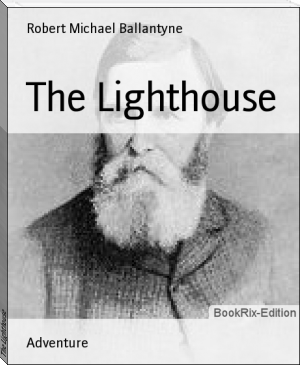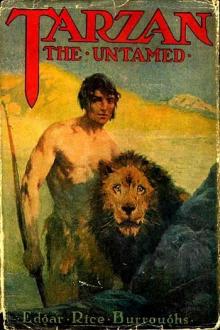The Lighthouse by Robert Michael Ballantyne (books for 5 year olds to read themselves TXT) 📖

- Author: Robert Michael Ballantyne
Book online «The Lighthouse by Robert Michael Ballantyne (books for 5 year olds to read themselves TXT) 📖». Author Robert Michael Ballantyne
As there seemed no possibility of bringing the matter home to him, however, he resolved to dismiss the whole affair from his mind in the meantime.
Things were very much in this state when, in the spring, the operations at the Bell Rock were resumed.
Jamie Dove, Ruby, Robert Selkirk, and several of the principal workmen, accompanied the engineers on their first visit to the rock, and they sailed towards the scene of their former labours with deep and peculiar interest, such as one might feel on renewing acquaintance with an old friend who had passed through many hard and trying struggles since the last time of meeting.
The storms of winter had raged round the Bell Rock as usual--as they had done, in fact, since the world began; but that winter the handiwork of man had also been exposed to the fury of the elements there. It was known that the beacon had survived the storms, for it could be seen by telescope from the shore in clear weather--like a little speck on the seaward horizon. Now they were about to revisit the old haunt, and have a close inspection of the damage that it was supposed must certainly have been done.
To the credit of the able engineer who planned and carried out the whole works, the beacon was found to have resisted winds and waves successfully.
It was on a bitterly cold morning about the end of March that the first visit of the season was paid to the Bell Rock. Mr Stevenson and his party of engineers and artificers sailed in the lighthouse yacht; and, on coming within a proper distance of the rock, two boats were lowered and pushed off. The sea ran with such force upon the rock that it seemed doubtful whether a landing could be effected. About half-past eight, when the rock was fairly above water, several attempts were made to land, but the breach of the sea was still so great that they were driven back.
On the eastern side the sea separated into two distinct waves, which came with a sweep round the western side, where they met, and rose in a burst of spray to a considerable height. Watching, however, for what the sailors termed a _smooth_, and catching a favourable opportunity, they rowed between the two seas dexterously, and made a successful landing at the western creek.
The sturdy beacon was then closely examined. It had been painted white at the end of the previous season, but the lower parts of the posts were found to have become green--the sea having clothed them with a soft garment of weed. The sea-birds had evidently imagined that it was put up expressly for their benefit; for a number of cormorants and large herring-gulls had taken up their quarters on it--finding it, no doubt, conveniently near to their fishing-grounds.
A critical inspection of all its parts showed that everything about it was in a most satisfactory state. There was not the slightest indication of working or shifting in the great iron stanchions with which the beams were fixed, nor of any of the joints or places of connexion; and, excepting some of the bracing-chains which had been loosened, everything wars found in the same entire state in which it had been left the previous season.
Only those who know what that beacon had been subjected to can form a correct estimate of the importance of this discovery, and the amount of satisfaction it afforded to those most interested in the works at the Bell Rock. To say that the party congratulated themselves would be far short of the reality. They hailed the event with cheers, and their looks seemed to indicate that some piece of immense and unexpected good fortune had befallen each individual.
From that moment Mr Stevenson saw the practicability and propriety of fitting up the beacon, not only as a place of refuge in case of accidents to the boats in landing, but as a residence for the men during the working months.
From that moment, too, poor Jamie Dove began to see the dawn of happier days; for when the beacon should be fitted up as a residence he would bid farewell to the hated floating light, and take up his abode, as he expressed it, "on land."
"On land!" It is probable that this Jamie Dove was the first man, since the world began, who had entertained the till then absurdly preposterous notion that the fatal Bell Rock was "land," or that it could be made a place of even temporary residence.
A hundred years ago men would have laughed at the bare idea. Fifty years ago that idea was realised; for more than half a century that sunken reef has been, and still is, the safe and comfortable home of man!
Forgive, reader, our tendency to anticipate. Let us proceed with our inspection.
Having ascertained that the foundations of the beacon were all right, the engineers next ascended to the upper parts, where they found the cross-beams and their fixtures in an equally satisfactory condition.
On the top a strong chest had been fixed the preceding season, in which had been placed a quantity of sea-biscuits and several bottles of water, in case of accident to the boats, or in the event of shipwreck occurring on the rock. The biscuit, having been carefully placed in tin canisters, was found in good condition, but several of the water-bottles had burst, in consequence, it was supposed, of frost during the winter. Twelve of the bottles, however, remained entire, so that the Bell Rock may be said to have been transformed, even at that date, from a point of destruction into a place of comparative safety.
While the party were thus employed, the landing-master reminded them that the sea was running high, and that it would be necessary to set off while the rock afforded anything like shelter to the boats, which by that time had been made fast to the beacon and rode with much agitation, each requiring two men with boat-hooks to keep them from striking each other, or ranging up against the beacon. But under these circumstances the greatest confidence was felt by everyone, from the security afforded by that temporary erection; for, supposing that the wind had suddenly increased to a gale, and that it had been found inadvisable to go into the boats; or supposing they had drifted or sprung a leak from striking upon the rocks, in any of these possible, and not at all improbable, cases, they had now something to lay hold of, and, though occupying the dreary habitation of the gull and the cormorant, affording only bread and water, yet _life_ would be preserved, and, under the circumstances, they would have been supported by the hope of being ultimately relieved.
Soon after this the works at the Bell Rock were resumed, with, if possible, greater vigour than before, and ere long the "house" was fixed to the top of the beacon, and the engineer and his men took up their abode there.
Think of this, reader. Six great wooden beams were fastened to a rock, over which the waves roared twice every day, and on the top of these a pleasant little marine residence was nailed, as one might nail a dovecot on the top of a pole!
This residence was ultimately fitted up in such a way as to become a comparatively comfortable and commodious abode. It contained four storeys. The first was the mortar-gallery, where the mortar for the lighthouse was mixed as required; it also supported the forge. The second was the cook-room. The third the apartment of the engineer and his assistants; and the fourth was the artificers' barrack-room. This house was of course built of wood, but it was firmly put together, for it had to pass through many a terrific ordeal.
In order to give some idea of the interior, we shall describe the cabin of Mr Stevenson. It measured four feet three inches in breadth on the floor, and though, from the oblique direction of the beams of the beacon, it widened towards the top, yet it did not admit of the full extension of the occupant's arms when he stood on the floor. Its length was little more than sufficient to admit of a cot-bed being suspended during the night. This cot was arranged so as to be triced up to the roof during the day, thus leaving free room for occasional visitors, and for comparatively free motion. A folding table was attached with hinges immediately under the small window of the apartment. The remainder of the space was fitted up with books, barometer, thermometer, portmanteau, and two or three camp-stools.
The walls were covered with green cloth, formed into panels with red tape, a substance which, by the way, might have had an _accidental_ connexion with the Bell Rock Lighthouse, but which could not, by any possibility, have influenced it as a _principle_, otherwise that building would probably never have been built, or, if built, would certainly not have stood until the present day! The bed was festooned with yellow cotton stuff, and the diet being plain, the paraphernalia of the table was proportionally simple.
It would have been interesting to know the individual books required and used by the celebrated engineer in his singular abode, but his record leaves no detailed account of these. It does, however, contain a sentence in regard to one volume which we deem it just to his character to quote. He writes thus:--
"If, in speculating upon the abstract wants of man in such a state of exclusion, one were reduced to a single book, the Sacred Volume, whether considered for the striking diversity of its story, the morality of its doctrine, or the important truths of its gospel, would have proved by far the greatest treasure."
It may be easily imagined that in a place where the accommodation of the principal engineer was so limited, that of the men was not extensive. Accordingly, we find that the barrack-room contained beds for twenty-one men.
But the completion of the beacon house, as we have described it, was not accomplished in one season. At first it was only used as a smith's workshop, and then as a temporary residence in fine weather.
One of the first men who remained all night upon it was our friend Bremner. He became so tired of the floating light that he earnestly solicited, and obtained, permission to remain on the beacon.
At the time it was only in a partially sheltered state. The joiners had just completed the covering of the roof with a quantity of tarpaulin, which the seamen had laid over with successive coats of hot tar, and the sides of the erection had been painted with three coats of white lead. Between the timber framing of the habitable part, the interstices were stuffed with moss, but the green baize cloth with which it was afterwards lined had not been put on when Bremner took possession.
It was a splendid summer evening when the bold
 Nowadays a big variety of genres are exist. In our electronic library you can choose any book that suits your mood, request and purpose. This website is full of free ebooks. Reading online is very popular and become mainstream. This website can provoke you to be smarter than anyone. You can read between work breaks, in public transport, in cafes over a cup of coffee and cheesecake.
Nowadays a big variety of genres are exist. In our electronic library you can choose any book that suits your mood, request and purpose. This website is full of free ebooks. Reading online is very popular and become mainstream. This website can provoke you to be smarter than anyone. You can read between work breaks, in public transport, in cafes over a cup of coffee and cheesecake.




Comments (0)